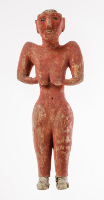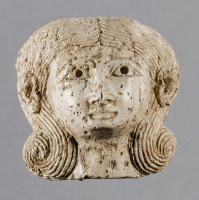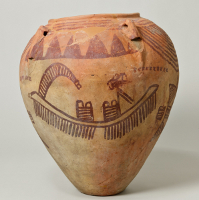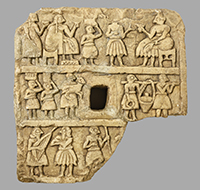Bronze Statuettes
 Archaeologists found these three statuettes in a cache that contained three male and three female figurines. They are the earliest known metal castings of human figures in the round from Syria. The males wear broad belts and helmets covered with a silver alloy; they probably once held weapons in their upraised hands. The naked females' hair is held in place with a headband and bound in the back in an elaborate chignon. They cross their arms and grasp their breasts in their hands - a common ancient pose that probably connotes fertility. The statuettes were intended to be mounted in some fashion, for a tang projects below the feet of each one.
Archaeologists found these three statuettes in a cache that contained three male and three female figurines. They are the earliest known metal castings of human figures in the round from Syria. The males wear broad belts and helmets covered with a silver alloy; they probably once held weapons in their upraised hands. The naked females' hair is held in place with a headband and bound in the back in an elaborate chignon. They cross their arms and grasp their breasts in their hands - a common ancient pose that probably connotes fertility. The statuettes were intended to be mounted in some fashion, for a tang projects below the feet of each one.
The skill with which these unique pieces were modelled and the technical knowledge that was needed for their casting reveal surprisingly high standards of artistic and technical achievement in Syria at the beginning of the third millennium B.C.
Mother Nursing Child
This simply formed and elaborately decorated nursing female probably represents a Cypriot mother goddess. Her facial features (including ears pierced for added earrings) and her limbs, breasts, and navel (?) are rudimentarily indicated. Bands of incisions suggest necklaces encircling her neck and patterns on her long, sheath-like garment. In her arms she holds an elaborate cradle containing an infant who suckles from her left breast.
Predynastic Jar
Most striking of the painted designs on this pot are the boats, which carry banks of oars, cabins or shrines, and standards. Other decorations include a large bird, probably an ostrich, and images evocative of the hills and water of Upper Egypt, where this vessel was made. Strings probably were passed through the four pierced beak-shaped lugs near the rim and used to tie a lid securely in place. Handmade pots with painted decorations like these were characteristic of the Gerzean period.
Male and Female Figures
 A naked female and a partially clothed male are represented by this unique pair of red-coated stone figurines. Hair or headdresses made of a separate material were probably once attached to the pegs atop their heads. The male, who stands with his hands at his sides, wears a loincloth tied at the back. The female grasps her breasts with her hands-a common ancient pose that probably connotes fertility. She appears to be naked except for some type of foot-gear applied to her stump-like feet.
A naked female and a partially clothed male are represented by this unique pair of red-coated stone figurines. Hair or headdresses made of a separate material were probably once attached to the pegs atop their heads. The male, who stands with his hands at his sides, wears a loincloth tied at the back. The female grasps her breasts with her hands-a common ancient pose that probably connotes fertility. She appears to be naked except for some type of foot-gear applied to her stump-like feet.
Female Figurine
Figurines like this one have been found in the excavated remains of Mesopotamian houses, temples, and other public buildings of the early second millennium B.C. They have no definite divine attributes and their exact function is not known. This female has characteristic broad, flat hips, a large and elaborately incised pubic triangle, and prominent breasts with applied disk-shaped nipples. The multiple holes pierced at the sides of her head may have held metal earrings or served to fasten the piece to a separate material, such as cloth.
Banquet Plaque
The top register of this plaque shows a seated man and woman celebrating an unidentified event or ritual by participating in a banquet. Two servants attend them while others bring a jar (probably filled with beer), an animal to be slaughtered, and other edibles carried in bundles on their heads. Musicians and dancers in the bottom register add to the festivities.
Plaques such as this were part of a door-locking system for important buildings. The plaque was embedded in the doorjamb and a peg, inserted into the central perforation, was used to hold a hook or cord that secured the door and was covered with clay impressed by one or more seals.
Three Female Heads
 These delicate heads belong to a group of ivories discovered at the site of Megiddo, in Palestine. They had been stored in a semi- subterranean chamber that archaeologists called "the treasury," within a large building that may have been a palace. Pairs of heads such as these were attached to cosmetic boxes. A dowel inserted behind one head functioned as the hinge for a flat lid; a dowel behind the other served to fasten the lid closed. The heads show traces of Egyptian influence in their heavily curling locks of hair, which are characteristic of the Egyptian goddess Hathor.
These delicate heads belong to a group of ivories discovered at the site of Megiddo, in Palestine. They had been stored in a semi- subterranean chamber that archaeologists called "the treasury," within a large building that may have been a palace. Pairs of heads such as these were attached to cosmetic boxes. A dowel inserted behind one head functioned as the hinge for a flat lid; a dowel behind the other served to fasten the lid closed. The heads show traces of Egyptian influence in their heavily curling locks of hair, which are characteristic of the Egyptian goddess Hathor.





